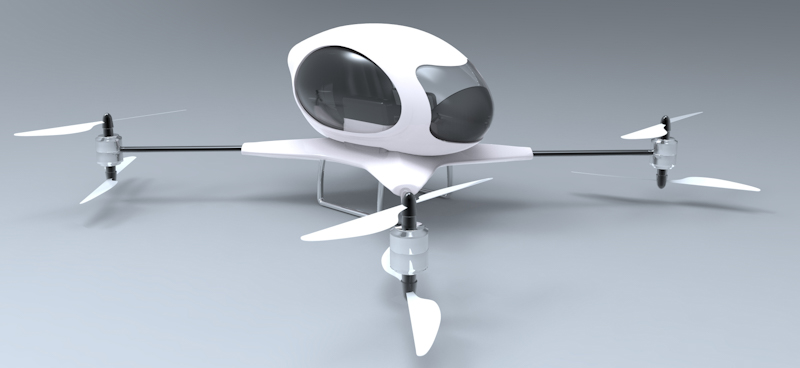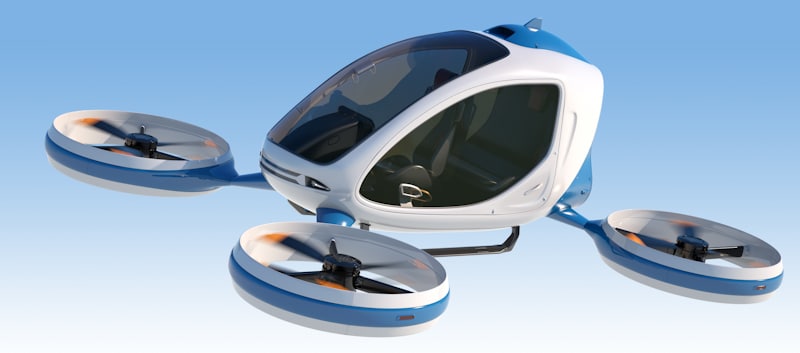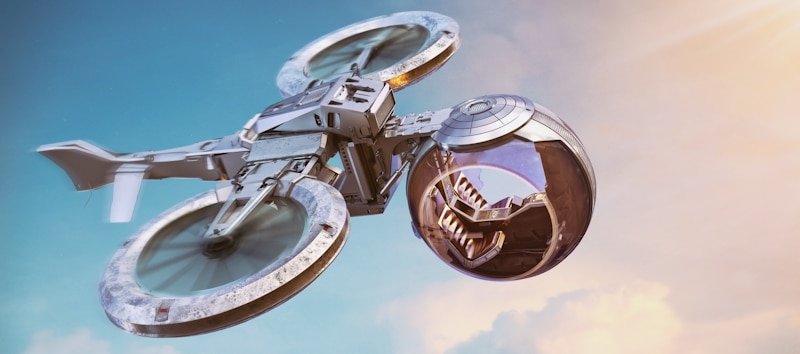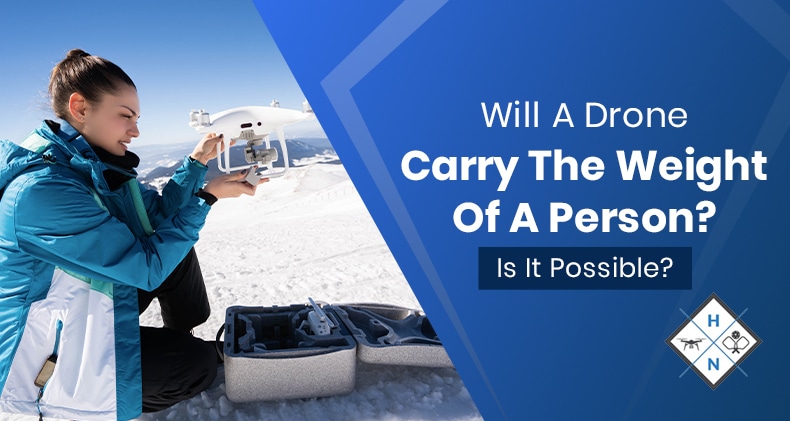Using drones to deliver products is an idea that is in pilot testing for quite some time now. It would, however, take a few years (at least) for the concept to come to fruition or become mainstream. But some curious folks already want to know whether drones are capable of transporting people.
Drones can carry humans around, but not the ones being used currently. Drones are traditionally compact and designed to survey hard-to-access sites or get aerials perspectives of areas. Larger, purpose-built drones can carry people. And quite a few drone makers are already at work.
The very first drone was created in 1935, but it wasn't the technological marvel then that it is now – not even close. Not to mention, modern-day drones are a lot more capable and versatile. Companies are channelizing all that technical know-how and experience to make some genuinely large-size drones. Read on to learn everything there is to the concept and the companies striving to realize the same.

Do Human-Carrying Drones Exist?
As mentioned above, drones capable of carrying fully-grown adults do exist (in concept). However, they are not meant for public use or aren't mass market yet. And looking at the plethora of laws and guidelines regulating the usage of drones that currently exist, these flying car-like drones may take quite some time to become a reality.
These mini helicopters are much larger and powerful compared to conventional drones. Not many drone manufacturers are making them or investing in the technology and infrastructure to make them, yet. The ones working on those large drones are extensively testing the aircraft for their efficacy, reliability, safety, and other attributes.
In other words, there is no human-carrying drone populating the skies yet.
So, how do these human-lugging drones are expected to look and perform?
There aren't many of these flying taxi concepts or prototypes around. But the ones that do exist look more like a cross between a quadcopter and a motorbike. They have the four rotors and blades typical of a drone, but they also have a seating area similar to a motorcycle.
But not all of these large drones look like a "hoverbike". Some are designed to look more like a helicopter with a proper enclosure for the person being levitated. And these are likely to carry more than one individual. These "drone taxis", "pilotless helicopters", or "flying taxis" fall under the PAV (personal air vehicle) category.
Companies Working on Flying Taxis
At CES (Consumer Electronics Show) 2016, EHang introduced the Ehang 184, an electric passenger-grade aerial autonomous vehicle.
A couple of years after the initial launch, the Ehang 184 was showcased by the company in real-world scenarios performing human test flights. The objective was to demonstrate the stability and safety levels of the flying taxi.
The drone taxi has four propellers and is fully electric. The Ehang 184 can fly for around 25 minutes at a stretch and travel at a speed of around 60mph (96.5kph). It could carry only one passenger at a time, and the maximum weight capacity was 220 lbs (99.8kg). All of this information was provided by EHang at the time of the unveiling.
However, the videos that the company released two years later exhibited the Ehang could carry two fully-grown adults, or the total haulage capacity increased to up to 460 lbs (208kg). Moreover, they bumped up the maximum speed to 80mph (128kph). It finished a routed test flight covering 9 miles (14.5km).
According to EHang, the Ehang 184 can also fly comfortably at night or during low-light conditions, in foggy weather, even when there's a mild typhoon-like situation.
Other Companies
As indicated above, EHang is not the only company to work on a flying taxi. Other firms such as Bell Textron, Airbus, Uber Air, Intel, etc., are throwing in their hats too. If you thought electric drone taxis had piqued only small startups' interest, the following pieces of information would refute that.
- Volocopter
Made by Volocopter GmbH, the German aircraft manufacturer, the Volocopter 2X is a two-seat, 18-rotor, optionally piloted electric helicopter. The drone has an enclosed cabin and could be flown or remotely handled like other drones.
The drone project began its journey in 2013, based on the Volocopter VC2 single-seat prototype from 2011. Funds were poured in to make the prototype VC200. The original design prototype flew crewless and indoors in November 2013. The flight had extremely low vibration in the cabin.
The VC200 version was the first prototype from the company to be flown outdoors, tethered and uncrewed, in November 2015. The first flight with a human inside took place in April 2016, and it came out with flying colors (pun intended). The testing of the aircraft's hardware and software continued in 2016.

Designed in compliance with microlight helicopter rules in Europe, the 2X is envisioned for urban air taxi services. The aircraft is in production since April 2018.
- Bell Helicopter
At CES 2018, Bell showed off its electric flying taxi. It did not exhibit the entire drone at the show but just the cabin to focus solely on the passenger experience. Its Nexus eVTOL (vertical take-off and landing) is a 4-seat, much larger than any single or two-seat flying taxis currently in testing or production.
Its huge six 90-degree tilting rotors are powered by an electric propulsion setup that uses a Safran turbine. There are two battery packs: one sitting atop the aircraft in the turbine's front, and the other pack positioned underneath the airplane's frame. The Nexus employs Bell's lift idea, with six tilting ducted fans that are relatively quiet.
Unlike EHang, which made its foray into making drones and related hardware in 2014, Bell has been in the aviation industry since 1943, having sold more than 35,000 helicopters till 2019. The company shifting its focus to electric flying taxis and conceiving a massive and eccentric design as the Nexus may be a massive surprise to people who are not familiar with the entity's experience and prowess.
- Airbus's Project Vahana
The company Airbus needs no introduction, but its Project Vahana is not as ubiquitous. With Project Vahana, Airbus aspires to make an electric VTOL airplane that is entirely self-piloted.
The self-piloting design has several advantages – the primary being it will help save costs attached to pilot hiring and training. Also, since it's automated, the taxi will return to its maintenance center when it's time or take another route depending on its current assignments.
The Vahana prototype went through its first full-scale flight test in 2018. The 20-foot-high airplane rose to 16 feet in the air, and it remained suspended for 53 seconds. Those numbers may not sound impressive, but the noteworthy thing is the drone achieved all of that using autopilot technology. Since the initial test, Airbus has conducted around 50 test flights of the Vahana.
The aircraft hasn't been officially released yet. The original plan was to showcase it in 2020, but that debut didn't happen. As of now, there's no update on when and where the Vahana will show face in all its glory. It's, however, safe to assume Airbus and the Vahana team are diligently at work.
- Moog Surefly
The Moog Surefly (formerly called Workhorse Surefly) is a VTOL that promises to offer a self-controlled, safe flying experience.
It was originally conceived and developed by Workhorse. In 2019, the firm sold its aviation department to Moog for approximately $4 million. The project's mounting expenditure and the company's inability to sustain the mission anymore were considered reasons. Currently, in the more reliable hands of Moog, work on Surefly's development is ongoing steadfastly.
The Surefly aircraft will come equipped with eight propellers and clock maximum speeds of 75mph (120.7kph). Unlike other flying taxis, the Surefly will run on gasoline, with a battery packing offering an additional 10 minutes of flight, whenever required. It's a hybrid that leans more toward traditional fuel usage.
The initial model is expected to haul around 400 lbs (181.5kg) of cargo. A more robust version is also expected, likely to carry a load of up to 650 lbs (295kg). Not to mention, commercial operators and particularly the American military have taken notice of the Surefly's promised capabilities.
- Opener's Blackfly
The Blackfly by Opener, a Canadian company, is a VTOL that blends personal piloting and multiple automatic features, such as automated return home and auto-landing functions. This enables flight without the requirement for formal licensing.
The design may look straight from a spaceship movie, but it's a lot more conventional aircraft at its core – at least with its operations.
There are eight rotors positioned across its dual wings. The take-off, however, is unique. It rocks front and back to gather momentum and launch upward. Its top speed is claimed to be 72mph (115.8kph), and it can cover 40 miles (64km) at a stretch. In reality, however, the laws and regulations may not permit such speeds.
- Terrafugia Transition
The Transition by Terrafugia is a flying car with wheels and retractable wings. The hybrid vehicle is designed to operate both in the air and on the ground with equal aplomb. The "hybrid" nature of the aircraft also implies it employs a gasoline-electric drivetrain that features a "boost mode" for additional speed burst when flying.

Terrafugia is currently owned by Geely, which owns Volvo, Polestar, Lotus, etc. It also has a 10% share in Daimler, Mercedes-Benz's parent company. Terrafugia is certainly in capable hands, which makes the Transition doesn't seem like a distant dream.
- AeroMobil
AeroMobil, a Slovakia-based company, is focused on making a flying car. First floated in 2013, the roadable aircraft is aimed at wealthy flight enthusiasts and supercar buyers.
The vehicle is designed to offer luxury car comfort. The company doesn't look at the mere ability to fly in a drone taxi as a premium experience. The designers also plan to bundle a ballistic parachute into the vehicle. The first production variant of the vehicle was released in April 2017.
The flying car was slated to release commercially in 2017 first. The date was then pushed to 2018. Later, the company announced their first drone car would be available for purchase in 2020 for a super-premium price tag of around $1.2 mn to $1.6 mn. It's 2021, and there's no news of an AeroMobil flying car yet.
The company has been quite unreliable with its plans and dates for launch. But it's still worth the wait – at least to witness what a car that's likely to be priced more than a million dollars will look and perform like.
- Porsche-Boeing Flying Taxi
Flying air taxis are "luxury items" by themselves. But with a company like Boeing with its core in aviation joining hands with Porsche, a carmaker known for its luxury sports cars, expect the premium quotient of drone taxis to go up several notches high.
The two companies have reportedly started work on a sleek winged drone taxi with a windshield that wraps around. The project is nowhere near completion. It still is in its nascent stage. But when two heavyweights of their respective industries come together, you can expect something truly advanced.
- Aston Martin and Rolls Royce
And Porsche is not the only "luxury automaker" to venture into (or show clear intent) the drone taxi space. Aston Martin and Rolls Royce are also joining in on the urban air commuting space party.
Aston Martin's Volante Vision, a design first introduced in 2018, will accommodate three passengers positioned triangularly. As of now (March 2021), the company has made public a few computer-generated pictures of their concept and stated their autonomous hybrid vehicle would take off vertically. The British sports car maker came up with the design in association with Cranfield Aerospace Solutions and Cranfield University.
Rolls Royce has its aeronautics division that has been making airplane engine designs since before World War I. The company provided Volante Vision's powertrain.
RR's aeronautics division released its drone taxi concept design in 2018 – highlighting the aircraft's capability to lug people and/or cargo. The claimed range is more than 500 miles (805km). The gas turbine-powered electric motors will afford the airplane the ability to clock a maximum of 250mph (402kph).
Are There Flying Taxis Available Commercially?
As of March 2021, mini helicopters are not available for commercial sale – at least not widely and certainly none of the ones mentioned above. Most are still confined to the testing labs of their respective companies. The Ehang 184 will take quite some time to mature into a product ready for the general consumer.
Though rigorous testing, the need for further refinements and enhancements, etc., are cited as reasons for the delay, EHang and other companies currently working on their drone taxis, flying drone bikes, etc., know proper laws on flying taxis are yet to be drafted.
As a result, most of them are not in any real hurry to speed up their operations, or they have no absolute deadline or target date as such by which they'll like to roll out their flying cars to the public.
The Volocopter accepts reservations for its electric flying taxi, but the drones will take flight only in 2023, which is after its commercial release in 2022. Volocopter has carried out test flights in Helsinki, Dubai, Singapore, and Bruchsal (Germany). Commercial flights are likely to happen in some or all of these cities.

Existing Battery Technology Is Also Pulling Things Back
Besides the reasons mentioned above, the hardware needed to support flying taxis is also in their infancy stages – particularly batteries. Flying needs an enormous amount of energy, and existing battery technologies simply do not provide enough power to achieve a lift that's sustainable for long.
This is why the aviation industry is nowhere close to coming up with electric airplanes in the near future. As per experts, it would take several years for batteries to have the needed power-to-weight ratio. Even traditional drone flight times are shortened due to this very reason.
Conclusion
Drones are getting popular with each passing day. Initially used by the military and then by research professionals for work and hobbyists for recreation, these mini airplanes have slowly but surely permeated all walks of human life. The levels of curiosity UAVs invoke, and the sense of excitement they create have all contributed to their surging popularity.
And this growing love and acceptance have pushed some manufacturers to make drones that are big and powerful enough to transport humans. However, the bad news is that (most of) these drones are still in their various stages of testing. And it might take a considerable time for them to get their bugs fixed and designs re-engineered and then eventually take shape as a final, commercial product.
And when these flying taxis do come out, they will most likely be ultra-expensive and also not available to everyone. The Ehang 184, for instance, is expected to be priced in the $200,000 to $300,000 range.
Moreover, the (yet-to-be-drafted) laws on drone taxis could majorly determine whether general consumers get their hands on a flying taxi or not in the first place. Looking at the stringent rules surrounding traditional drones, it could be decades before flying taxis become a reality and not just a novelty.
Shawn Manaher loves to play with new toys and dive into new hobbies. As a serial entrepreneur, work definitely comes first but there is always room for hobbies.

